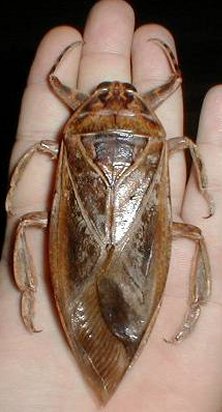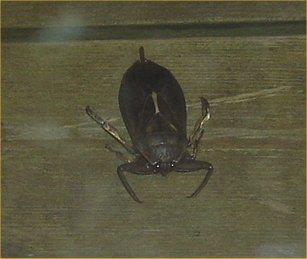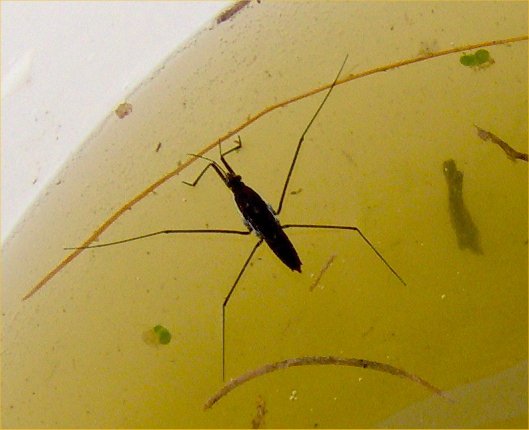 |
 |
|
|
Last Updated: 9/28/16
Introduction
Backswimmers
Broad-Shouldered Water Striders
Creeping Water Bugs
Giant Water Bugs
Marsh Treaders
Pygmy Backswimmers
Water Boatmen
Water Scorpions
Water Striders
Water Treaders
Toad and Shore Bugs
There are "bugs" which include insects, arachnids, centipedes, millipedes, and sometimes other small animals, and then, there are "true bugs." These are the real bugs! And, unlike most aquatic insects who only live in water from eggs to pupae and then leave as adults, many true bugs live aquatic lives even as mature adults.
Hemiptera include the common water striders, water boatmen, backswimmers, water scorpions, and water bugs. All of these stay around the pond as adults as well, eating small animals, insects, and fish. I find water boatmen to be cute. On the other hand, their mouths are made to pierce and suck which does not sound too pleasing. True bugs are good swimmers and clingers and prefer to eat insects. Some species follow.
There are, of course, also non-aquatic true bugs. Here are some photos of one example. These are milkweed bugs
that I found on my milkweed on 9/18/16:
Milkweed Bugs
Milkweed Bugs - note the shed exoskeletons hanging
on the bottom left
Milkweed Bugs - at the upper left are also oleander aphids.
Backswimmers are similar to water boatmen but they swim on their backs.and only grow to about 0.5 inches. They store air under their bodies. North America has about 20 species. Look but do not touch them; their bite is painful. One genera is Notonectdae. Backswimmers eat insects by piercing them with their sharp proboscis and sucking out their insides. Also called water bees, they can kill small fish and tadpoles as well. The common backswimmer is Notonecta undulata.
On 5/21/10, Betsy sent these photos of a worm for identification. It may be a horsehair worm.
There are two backswimmers in the photo.
Pond worm and backswimmers
The broad-shouldered water striders include the genuses Microvelia and Rhagovelia (which has hairy tufts on its legs for paddles). The 20 or so North American species catch small creatures on the surface and grow up to 0.5 inches.
Creeping water bugs also carry air, under their wings. These 0.3 inch bugs have strong legs and move through the water slowly, unlike water boatmen and backswimmers who just fly!

The largest true bugs of all are the giant water bugs, growing up to 3 inches. Their poisonous bite can kill small fish, tadpoles, and insects easily. Of the 24 species, some species practice male brood care where the male carries the eggs along his back even though they weigh a lot. One species, Lethocerus americanus grows to about 2 inches and likes to eat insects, tadpoles, fish, and salamanders. If the adults or nymphs are picked up, they pretend to be dead but can stab you with their beaks.

Cheryle from Alberta, Canada sent this photo for identification on 10/6/10. It is a giant water
bug.:
Giant water bug
A giant water bug photo courtesy of Kelly and "The Black River Action Team." She sent insect photos on 6/20/12. Thanks!
Drawings of a larval and an adult giant water bug can be seen at this water bug site.
The marsh treader or water measurer is a slender, stick-like stalker that hides among thick plants. They spear prey with a beak and suck out the body fluids. There are six species known in North America. Hydrometra martini is a species that grows to about 0.5 inches.
One species of pygmy backswimmer, Plea striola, lives in North America. It grows to 0.1 inches and swims between patches of plants eating small crustaceans. It looks a little like a flea.
Water boatmen are common. They are often seen swimming in the water column in ponds and swimming pools. Water boatmen look like a submerged canoe with two men paddling. They may have a pocket of air around their 0.25 to 1 inch bodies. They eat algae, detritus, and other stuff off of the bottom. Their weak proboscis sucks up the food. Of the 115 or so species, two common genera are Arctocorixa and Corixa or Corixidae.
Drawings of a larval and an adult water boatman can be seen at this water bug site.

Water scorpions are nasty looking insects. Hiding underwater with a snorkel or breathing tube (formed from their rear legs), they seize passing prey with strong legs and kill it. Since they grow up to 2.5 inches, finding one of these skinny, stick-like insects with large pincher legs often sends ponders into a panic. Yes, all 12 North American species do eat small fish; however, these ambush predators consume mostly insects.
Drawings of a larval and an adult water scorpion can be seen at this water bug site.

Ordinary water striders catch prey on the surface. They are also called water skaters, pond skaters, or Jesus bugs (since they walk on water). Growing up to an inch, the 30 or so species often congregate on the surface of ponds where they zip around the surface. They eat insects stuck on the surface but mine seem to hunt newborn fry also. Water striders court by sending water ripples to each other. Gerris marginatus is one species which grows to about 0.8 inches. The common water strider is Gerris remigis and grows to a little over half an inch.
This water strider was hanging out in the 153 gallon pond on 3/30/13 when I cleaned it out.
Water strider waiting in a kiddie pool.
Water strider in my 153 gallon pond on 4/12/15.
Drawings of a larval and an adult water strider can be seen at this water bug site.
Also see an article called "Water Striders do the locomotion by 'sculling,' scientists discover" for an interesting article on water striders.
Three species of water treaders live in North America. An example is Mesovelia mulsanti which grows to 0.5 inches. They are green and live concealed on the surface and eat small animals.
Finally, there are 0.3 inch toad and shore bugs who live near water and tend to go for dead bugs.
1
|
|
Return to the main insect page.
See the master index for the insect pages.

|

|
E-mail RobynCopyright © 1997-2026 Robyn Rhudy |

|
 |